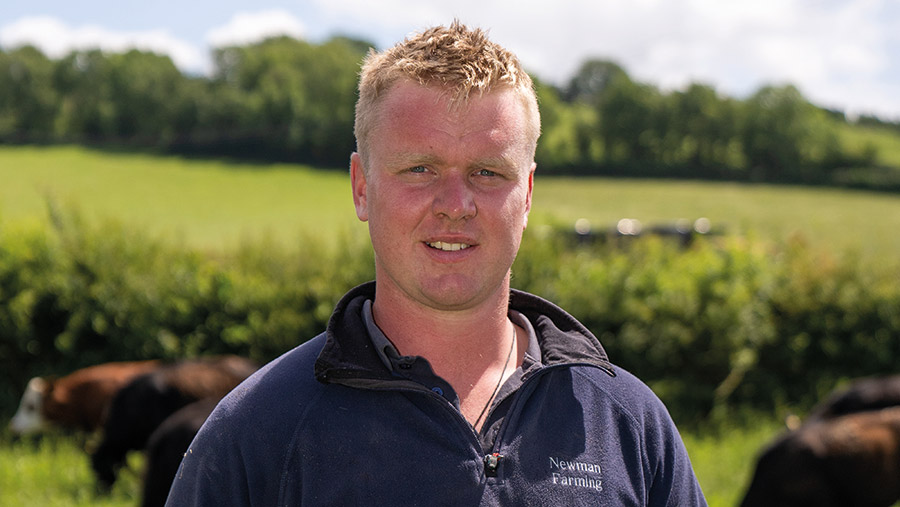How a dedicated isolation unit helped a calf-rearing business
 MAG/Tom Askew-Miller
MAG/Tom Askew-Miller Setting up a dedicated TB isolation unit and selling weaned calves has allowed Farmers Weekly Young Farmer of the Year Bertie Newman to increase output on his 607ha (1,499-acre) organic farm in Dorset.
Mr Newman, 25, set up a dairy-beef calf-rearing facility in autumn 2019 by converting an existing shed on rented ground and sourcing dairy-beef calves from TB-restricted holdings.
“We are organic, and part of being successful in that is having lots of hectares,” he says.
See also: Farmers Weekly Awards 2020: Young Farmer of the Year
“But that has its limitations. I got to a point where I realised there were only so many suckler calves I could keep, so I started thinking about how I could produce more beef from a smaller number of hectares.
“There was also our carbon footprint to consider. Rather than my friend getting rid of his calves, I could rear them, but without the carbon footprint of the cow,” he explains.
Farm facts
Manor Farm, Dorchester, Dorset
- Organic farm
- 607ha (1,499 acres) farmed – 132ha (326 acres) owned land and 475ha (1,173 acres) rented land
- 100 suckler cows, finished on farm
- 850 North Country Cheviot ewes
- Dedicated calf-rearing facility, predominantly for bought-in Angus- and Limousin-cross dairy calves
About the unit
Calves come into the unit in batches – based on the supplying farm’s spring and autumn calving pattern – at two weeks old.
This means picking up calves weekly as the unit has to be filled and closed within six weeks.
“I started off with a batch of 40 calves, but this spring I will have about 200,” says Mr Newman.
“The isolation unit is farmed conventionally, so that means we have a completely separate entrance and way of doing things.”
On arrival, the calves are weighed and the information documented using the Breedr app. Calves are put straight on to milk powder, which is fed twice a day via a 10-teat feeder.
At three weeks old, milk feeding frequency is dropped to once a day, although the same amount of milk powder concentrate is used.
“This works for us. The calves are happy because they are still getting the same amount of milk powder, and it makes things easier from a labour point of view, too,” he adds.
Cake is fed ad-lib and the calves are bedded up at least once a day to ensure enough straw is there for feeding.
Weaning takes place at around eight weeks, or when calves are eating 2kg cake a head a day and are hitting the target weight of 75kg, explains Mr Newman.
“If they are not quite ready, we will keep them back a week or two. Condition and health are more important than just targeting dates.”
Marketing and lessons learned
Post-weaning – and after two clear TB tests – the youngstock get sold privately as weaned calves.
Because they are reared conventionally, and are not certified organic, Mr Newman cannot bring the calves onto his main holding.
Instead, they are sold privately as weaned calves following two clear TB tests.
One of the biggest lessons has been just how important biosecurity and animal husbandry is in calf rearing, he says.
“Disease control is essential, and everything is washed out thoroughly twice a day. Water and bedding have to be clean.
Compared with suckler calves, for example, this way of rearing means calves have to be ‘nannied’ all the way through.”
He adds that having a good relationship with the supplying dairy farmer is key.
“Something we have definitely learned is that it is so important to ensure calves are getting good-quality colostrum before they come to you.
“This lays the foundations for their growth and performance and without it, it makes rearing difficult. If you have any concerns, I recommend asking to quality-test colostrum.”
Isolation unit pros and cons
Mr Newman says setting up an isolation unit can be expensive.
He explains: “There are strict specification requirements, and it can be expensive to keep up with these.
“For example, using concrete panels to seal the shed [up to 1.5m] can cost anywhere between £300-£400 a panel.
On the plus side, Mr Newman says it is a great way of growing your business without a huge land requirement and, more importantly, solving the challenge of finding a market for calves from TB-restricted holdings.
“For the buyer, rearing calves in this way means that they are very even in their growth and quality, which can be helpful for cashflow.”
Future
Efficiency across the whole farm is the focus of Mr Newman’s future plans.
“We are pretty much at our limits in terms of stocking numbers on-farm, so the future is going to be about tweaking things to make sure we are running as efficiently as possible.
“At the moment, we are looking at things like herbal leys and seeing how they could be useful for us.”
He has also just purchased a forage wagon to make chopped silage rather than bales in a bid to reduce plastic – owing to its cost and its environmental impact.
“Farming with the environment in mind is going to be key going forward,” he says.
Farmers Weekly Awards 2021
Join Farmers Weekly in celebrating the farming industry and recognising the hard work of UK farmers.
For more information about the 2021 Farmers Weekly Awards, visit the official website.
